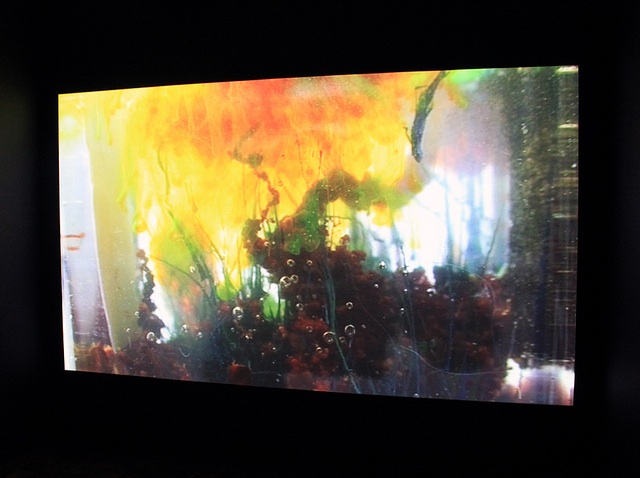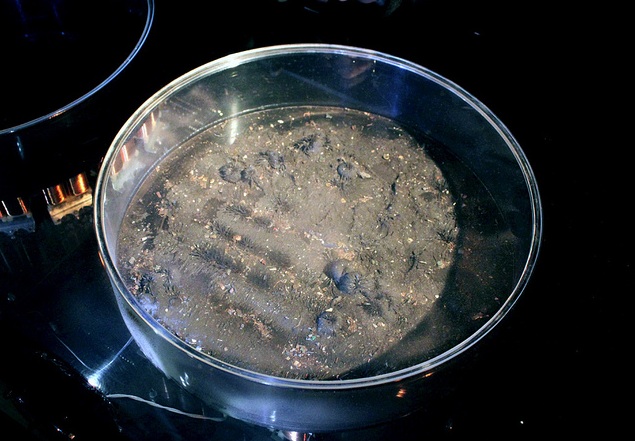Herwig Weiser

Still image from the installation “Lucid Phantom Messenger” 2010
Notes on “Lucid Phantom Messenger”:
The installation Lucid Phantom Messenger presents a setting that reminds us of a scientific laboratory in which the cold cobalt lighting and clean perspex surfaces distance us from what we’d love to submerge in. The work departs from the expressionism of action painting, in which materials are liberated from a servile function towards representation and become transformed into abstract gestures and shapes of sculptural painting. The tension between technical and organic elements, between the known and the unknown, between systematic analysis and free associations that grow in our brains as if imitating the process we see before us – all these juxtapositions are combined here to form a most unique experience.
Various electro-chemical processes that are programmed at the control electronics degenerate, liquefied high-tech materials, which were originally developed for digital image production and transport of information (liquid crystals, silicon, optical fiber, etc.). The installation translated and materialized the transformation process of digital imaging technologies in analog, spatial mechanisms that together produce an electro-chemical image-space sculpture. Due to the complex electrochemical processes, the dynamic nature of these materials will take shape there. Live in sculptural processes are “digital software and hardware interact with each other and brought materialized as analogous phenomena.
The formal implementation of the installation is a networked architectural structure consisting of various Plexiglas elements that form a “reaction cells,” an abstract urban landscape. In this cell architecture, the microstructures of various materials react by polarized light frequencies and their chemical and optical properties in a system that is controlled electronically and is composed of anode, cathode, electrode, ultrasound, and a valve frame. In this structure, made of Plexiglas elements, digital images are transmitted with a specially developed software in the system. There is formed in an analogous process, namely electro-chemical material processes, from a dynamic sculptural image.
Degenerative processes occur and reorganize material sculptural accumulations within the architectural units of different reaction cells. The transforming materials form polygenerative networks in an electro-chemical-optical evolving picture. developed from the raw substances are controlled by an electrically charged liquids, self-proliferating, degenerated system that is largely self-sufficient and operates in a non-temporary framework.
Through various thermochromic processes of image resolution and image formation, and by a “cut” into the geometry of “information representation”, a “software-action-painting”. Breaking the visualization and degeneration of existing image architecture, the “black box” of the digital images on computer and generating a polychromatic, analog and dynamically changing image sculpture set against it.
The material transformations of the electro-chemical image surfaces are also directly translated means of various sensors in sound structures. These sound structures are produced by electro-chemical induction and ultrasonic waves. The sound software that is fed back to the control electronics installation digitized, and in turn strengthened the processes of materials, which thus become “materialized Sounds”.
Electronic images using algorithms usually generate virtual surfaces. My new work “render” the software requirements of these images directly into the real, material surfaces of electronic media. About the staging and technical-abstraction of the physical flow of information, the terms of the electronic image to emerge. My concern is the diversion of the electrically-coded signals of conventional imaging technologies in experimental areas, materials and architectures “liquid Codes.”
In collaboration with the laboratory of Happyplating I am working since 2005 on various prototypes of this liquid, organic-generated machines. Albert Bleckmann created the PLC software for real-time automation processes and developed the mechatronic components of the installation.
In Berlin, the whole installation will be produced after early 2008, a prototype built with the assistance of the Vienna BMUK could. For the sound level of the project I will develop with Sukandar Kartadinata (glui Berlin) together a special interface that can respond to the chemical processes and the electricity flowing, and so these changes as appropriate tonal control for processes to use.

Still image from the installation “Zgodlocator – Version 3.0” 1998 – 2002
zgodlocator-deaf03
Herwig Weiser – Zgodlocator, Version 3.0, 1998-2002
Note on the artist:
Interested in the components of computations. Thinking about computing physical materials of what makes up a computer.
Herwig Weiser’s complex, computer controlled constructions and room sized mechanisms may initially appear as high-tech utopian visions but essentially they are the antithesis of the rational, technocratic efficiency and banal materiality of the computer. Instead, they have more in common with the early mechano-kinetic investigations of Marcel Duchamp and Laszlo Moholy-Nagy or even the stacked TV sculptures of Nam June Paik. Weiser also adds a new and contemporary dimension to the classical nexus of art and technique by appropriating the industrial new media of his time to create fully functioning art-machines defined by their own inherent logic or purpose.
In the gallery-filling feat of engineering that is zgodlocator, these base materials include the reduced electronic components of the computer itself: crushed and granulated circuit boards, hard drives, processors, plug connectors etc. The purpose: to create a machine that restructures the basic magnetic principles of the computer’s hard disk to create instead a fluid, fully interactive synthesis of sound with the syntax of sculptural form and visual expression.
Within the raised platform structure, the magnetically sensitive computer-fragments are laid over super-charged electromagnetic grids beneath a circular, centrally illuminated panel. Attached joysticks allow the audience to manipulate the movement of the metallic particles over the magnets—shaping dynamic transformations of the materials into uncanny landscape-like abstractions. At the same time, contact microphones and sensors sample, synthesize and amplify the raw audio generated and convert it back into sound-patterns and shifting undulations in the surface landscape. Zgodlocator may well transform the computer into something reflective and ephemeral, yet its premise as a machine remains assuredly logical. It touches on the implicit human impulse to find meaning in the random and the nonsensical, safe in the knowledge that every action has an equal and opposite reaction.
His artist biography can be found here : Herwig_Weiser_selected works